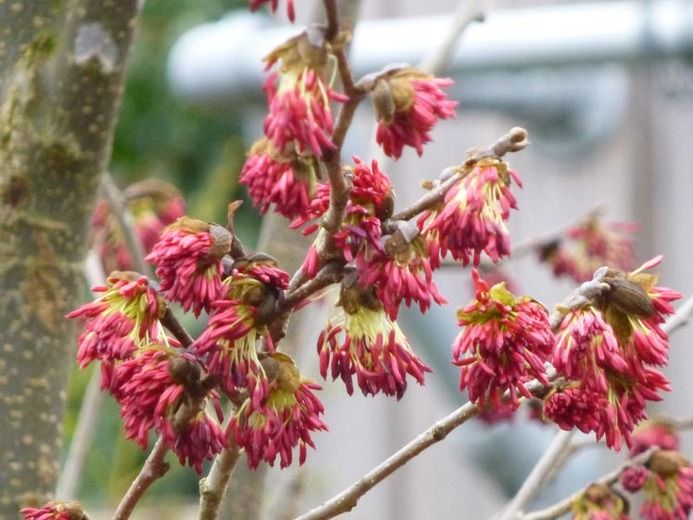Parrotia persica ‘Vanessa’, commonly known as the Persian ironwood or Vanessa Persian parrotia, is a stunning deciduous tree admired for its unique exfoliating bark and stellar fall foliage As a medium-sized, upright tree that typically matures to 20-40’ tall and 15-30’ wide, it’s well-suited for residential landscapes or parks. This ornamental tree provides year-round visual interest as well as amazing fall color
Quick Facts
- Genus and Species: Parrotia persica
- Cultivar: ‘Vanessa’
- Common Names: Vanessa Persian parrotia, Persian ironwood
- Family: Hamamelidaceae
- Mature Size: 20-40′ tall x 15-30′ wide
- Growth Rate: Medium
- Sun Exposure: Full sun to part shade
- Soil: Moist, well-drained, acidic
- Fall Foliage Color: Yellow, orange, red
- Flower Color: Deep red
- Hardiness Zones: 5-8
Origins and History
Parrotia persica is native to northern Iran and was discovered there in the 1800s The species name “persica” refers to its Persian origins. Parrotia trees grow at moderate altitudes in the Alborz mountains of northern Iran
This small to medium-sized tree was introduced to Europe and North America in the mid-1800s. The cultivar ‘Vanessa’ was discovered as a branch sport on a Parrotia persica tree at the Vanessa Nursery in France. ‘Vanessa’ emerged as an improved selection due to its fast growth rate, tolerance of urban conditions, and fantastic fall color.
Growth Habit
‘Vanessa’ Persian parrotia forms a narrowly upright, pyramidal shape with tiered, horizontal branching. It has a medium growth rate, gaining about 1-2′ per year until reaching maturity. Mature heights range from 20-40′ with a 15-30′ spread. The crown shape remains neat and tidy.
This compact, deciduous tree is well-suited for urban planting due to its tolerance of pollution, soil compaction, drought, heat, and ash. It’s easy to transplant. ‘Vanessa’ adapts well to various soil types but prefers moist, well-drained, acidic soil. It grows best in full sun but also tolerates partial shade.
Ornamental Features
‘Vanessa’ parrotia provides year-round visual interest with its exfoliating bark, spring flowers summer foliage and extremely showy fall color
-
Winter/Early Spring Interest: During the dormant season, the patchwork patterns of cream, amber, green, gray, and brown bark are revealed on mature trunks and branches.
-
Spring Flowers: In early spring before the leaves emerge, this parrotia is cloaked with clusters of tiny deep red flowers. The flowers have inconspicuous petals but showy bright red stamens.
-
Summer Foliage: The 4-6″ wide leaves are oval with serrated edges. They emerge reddish-purple before turning green. The foliage provides a nice contrast against the exfoliating bark.
-
Fall Color: ‘Vanessa’ explodes with brilliant shades of yellow, orange, and red in fall. The intensity of color lasts for several weeks.
Uses in Landscapes
Thanks to its multi-season appeal and medium size, ‘Vanessa’ parrotia is ideal for many landscape uses:
-
Specimen Tree – Its ornamental traits make it shine when planted alone as a focal point. Place it where the exfoliating bark and fall color can be admired up close.
-
Street Tree – Its upright form, pollution tolerance, vibrant fall color, and attractive bark add beauty and interest to streets. Provide enough room for the crown to develop.
-
Accent – Position it against a backdrop like an evergreen hedge to really make the bark and fall color pop.
-
Parks and Public Spaces – Adds seasonal interest to parks, commercial sites, university campuses, etc. Allow space for it to mature to full size.
-
Residential Landscapes – Provides year-round beauty even in small yards. Dwarfs homes nicely when used as a specimen near entries or corners.
Care and Maintenance
‘Vanessa’ Persian parrotia is relatively easy to grow:
-
Watering – Requires occasional irrigation during drought periods after establishment.
-
Soil – Adapts to various soil types and pH levels but prefers moist, acidic, well-draining soil. Avoid soggy sites.
-
Sunlight – Thrives in full sun to partial shade. For best fall color, provide at least a half day of sun.
-
Pruning – Requires little pruning beyond removing dead or damaged branches. Prune in late winter.
-
Pests – No serious pests, although scales may sometimes be a nuisance.
-
Diseases – Quite disease and pest resistant. Occasionally affected by verticillium wilt, armillaria root rot, and canker diseases. Improve airflow and avoid overwatering.
Finding ‘Vanessa’ Parrotia Trees
You can buy ‘Vanessa’ Persian parrotia trees at local nurseries that carry ornamental trees or order them online. They are sold in containers or balled and burlapped. Make sure to give them plenty of room to reach mature size.
For the most intense fall color display, select a site with full to partial sun exposure. Proper placement will allow you to enjoy the striking exfoliating bark patterns and fabulous fall foliage of this stellar specimen tree all year long in your own landscape!
Persian Ironwood (419-84* is in the Central & Western Asia
East Side and West Side
Find on the Map
Enter keywords to search on the arboretum map.
Parrotia persica ‘Vanessa’ (Persian Ironwood)
FAQ
How tall do Parrotia persica Vanessa get?
How big do Parrotia persica get?
How fast do Parrotia trees grow?
What is the lifespan of a Parrotia persica tree?
- The Ultimate Guide to Growing Strawberries in Raised Beds - August 8, 2025
- No-Dig Garden Beds: The Easiest Way to Grow a Beautiful Garden - August 6, 2025
- How to Protect and Preserve Wood for Raised Garden Beds - August 6, 2025

